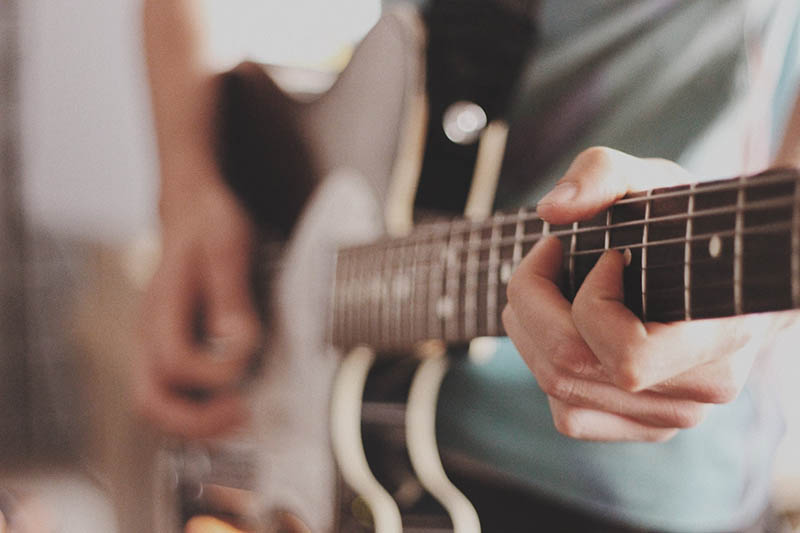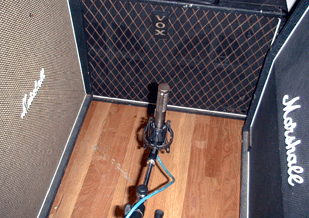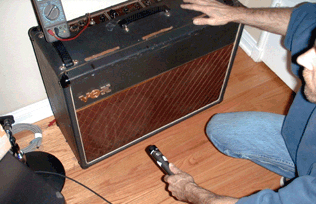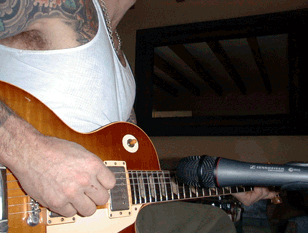
Multiple Miking
This is a good way find out which speaker sounds the best in a 4 x 10 cab, and you can put each mic on a separate track and pan them left and right. Be careful with phase, as some speaker manufacturers deliberately wire multi-speaker cabinets in and out of phase.
Some engineers will use a condenser on one speaker and a dynamic or ribbon on another, but I like to find the best speaker and use two mics on that speaker. Even then, I sometimes hear a little “phasiness” between the microphones.
A very popular setup is an SM57 up close and then, four or five feet away, a U 87 or the tube U 67 for a cabinet mic.
In The Middle
In Figure 6, I use a Royer R-121 equidistant between a 1960s 4 x 10 Marshall straight cabinet and a reissue 4 x 10 slant cabinet.Both cabinets are driven by a single top, and it won’t work unless one of the cabinet’s speaker cable is wired out of phase, (or you have determined the cabinets are already out of phase with each other).

With both speaker cabinets pushing and pulling together and the warm sound of the ribbon in the middle, you’re not going to get any fatter tone, especially for clean sounds. (The VOX cabinet was not in play here… but who knows?)
Scientific Starting Point
Figure 7 shows a scientific approach to mic placement on a Beatles AC30 VOX amp. The tech in the picture is using test instruments rather than his ears to find the “sweet spot.”

Sound waves coming out of a guitar amp emanate in all directions, setting up patterns much like a stone produces when thrown into a very still and flat pond. Like in the water, sound waves interact producing multiple reflections and standing waves where sonic energy coalesces. The idea is to place the mic where sound waves add together.
Determining this position requires a way to measure output level of a microphone while it’s moved around in front of the amp. First, set up for a guitar overdub with your microphone choice and fix the headphones so the musician can hear himself – unplug all headphones.
Then send a steady 700 Hz oscillator tone into the guitar amp’s input jack and place a large VU meter so it can be seen from wherever the guitar speaker cabinet or combo amp is located.
If this is impossible to do, plug a voltmeter into the cue system and read the level there. Setting the meter to read mid-scale with the cue system level control and with ear protectors on, (let’s make this science project as painless as possible), the mic should be moved around the front of the amp.
In doing this, you’ll find many peaks and dips in level. Also, I try to stand behind the speaker so that my body doesn’t affect the measurement process.
Obviously, as the mic gets closer to the speaker the level goes up, but if you keep a fixed distance and then move the mic left, right, or up and down, you’ll find a peak level. This is where you should set the mic.
Other Methods
These are some other ways to accomplish the task of recording guitar amps. Whether used alone or in combination with the aforementioned, all require much more experimentation and studio time.
Room Mics
Placing mics around the room is useful for effect, especially if you are recording in a great sounding space. This is an easy way to dress up a boring guitar sound, and there’s a lot of room to experiment! (Pardon the pun…)
Try different distances and heights, microphone types, EQ, compression and delay. I sometimes tape pressure zone microphones to the control room glass, or leave the studio doors open, or put a mic down a hallway. If you have an elevator shaft or stairwell handy, use that – put the amp at the bottom and a mic at the top.
Recording The Electric, Acoustically
Figure 8 shows a Sennheiser e865 handheld condenser miking the “holy grail” of electric guitars: a 1959 Les Paul Sunburst.

Obviously, the amp should be placed in another room for this to work. But I have recorded amps and mics on separate tracks and it makes a very unique combo. Great for arpeggios!
Direct Recording
Direct recording, also called “DI,” from the British term “direct injection,” is simply recording the output signal of the guitar itself. Electric bass guitar is almost always recorded this way because of its super present and clean sound.
Guitarists like to play through some type of stomp box or pedal just to “vibe up” this very pristine sound. There is a whole category of guitar pedals, processors and effects, all meant to be recorded directly. Whether you use a stomp box or not, here are a few caveats for getting the best sound from your guitar or bass.
Remember that the typical output signal of an electric guitar is very low level and very high impedance. Low level means that it will need amplification, and the high impedance requires matching to your recording system.
